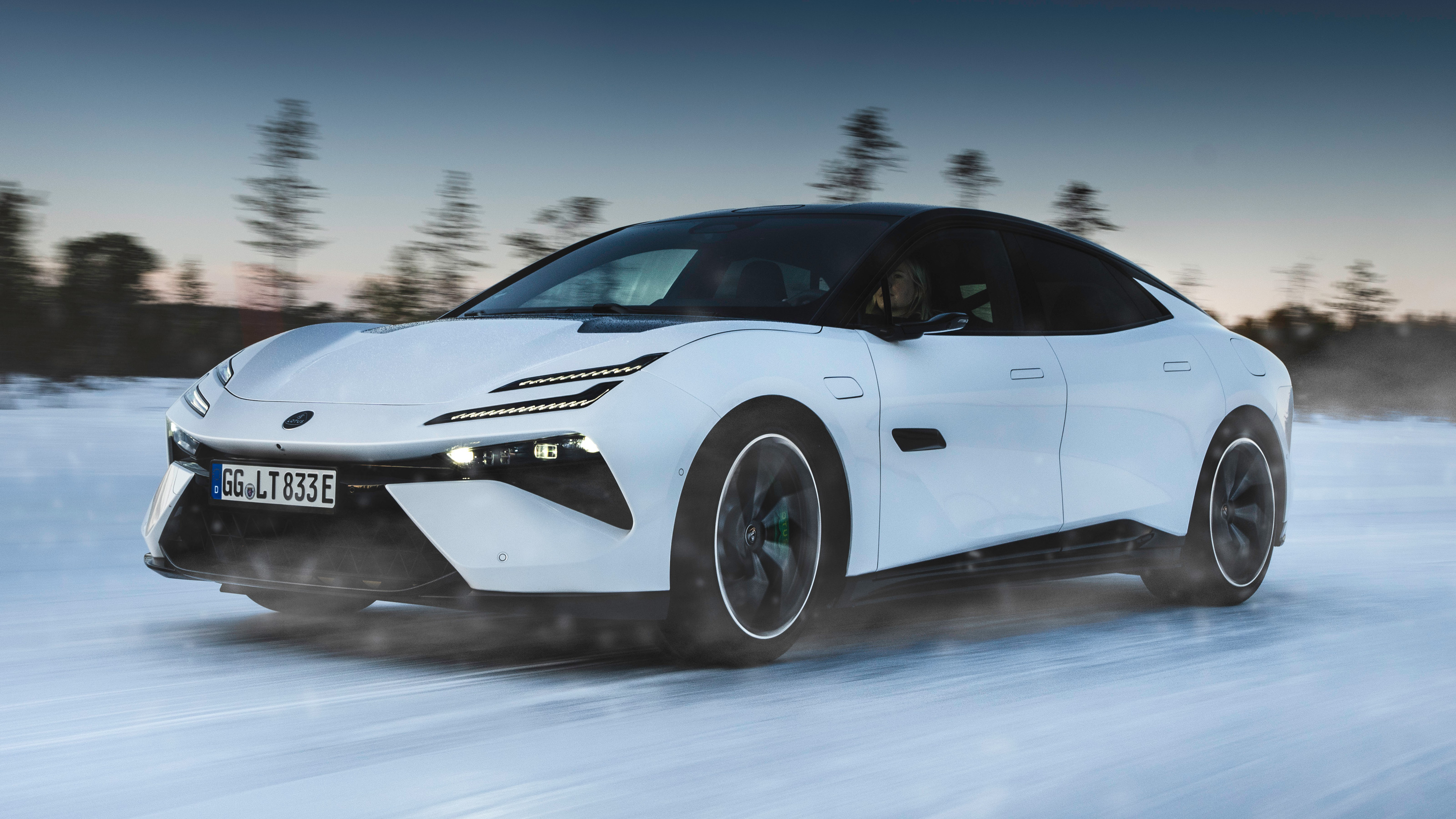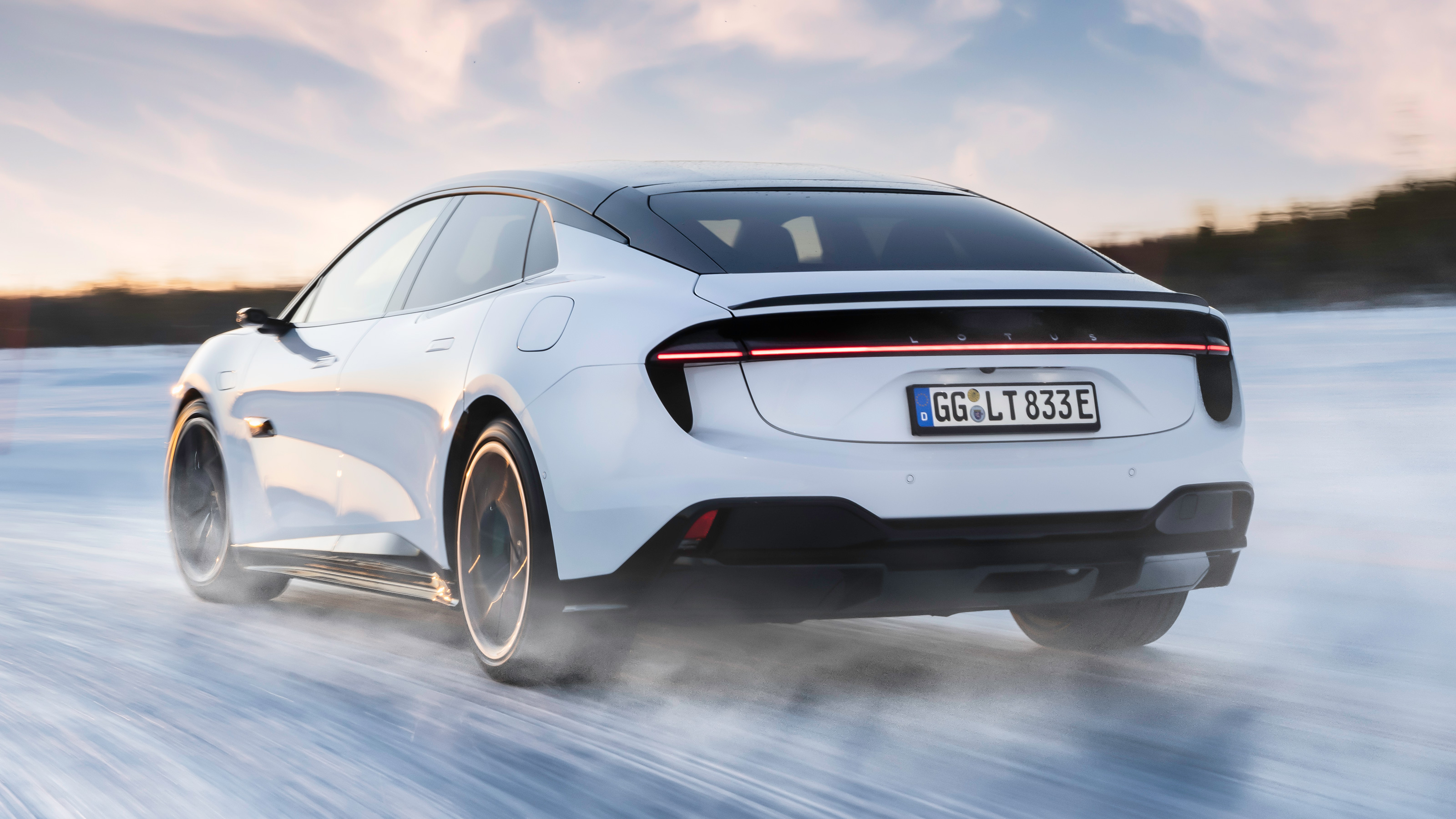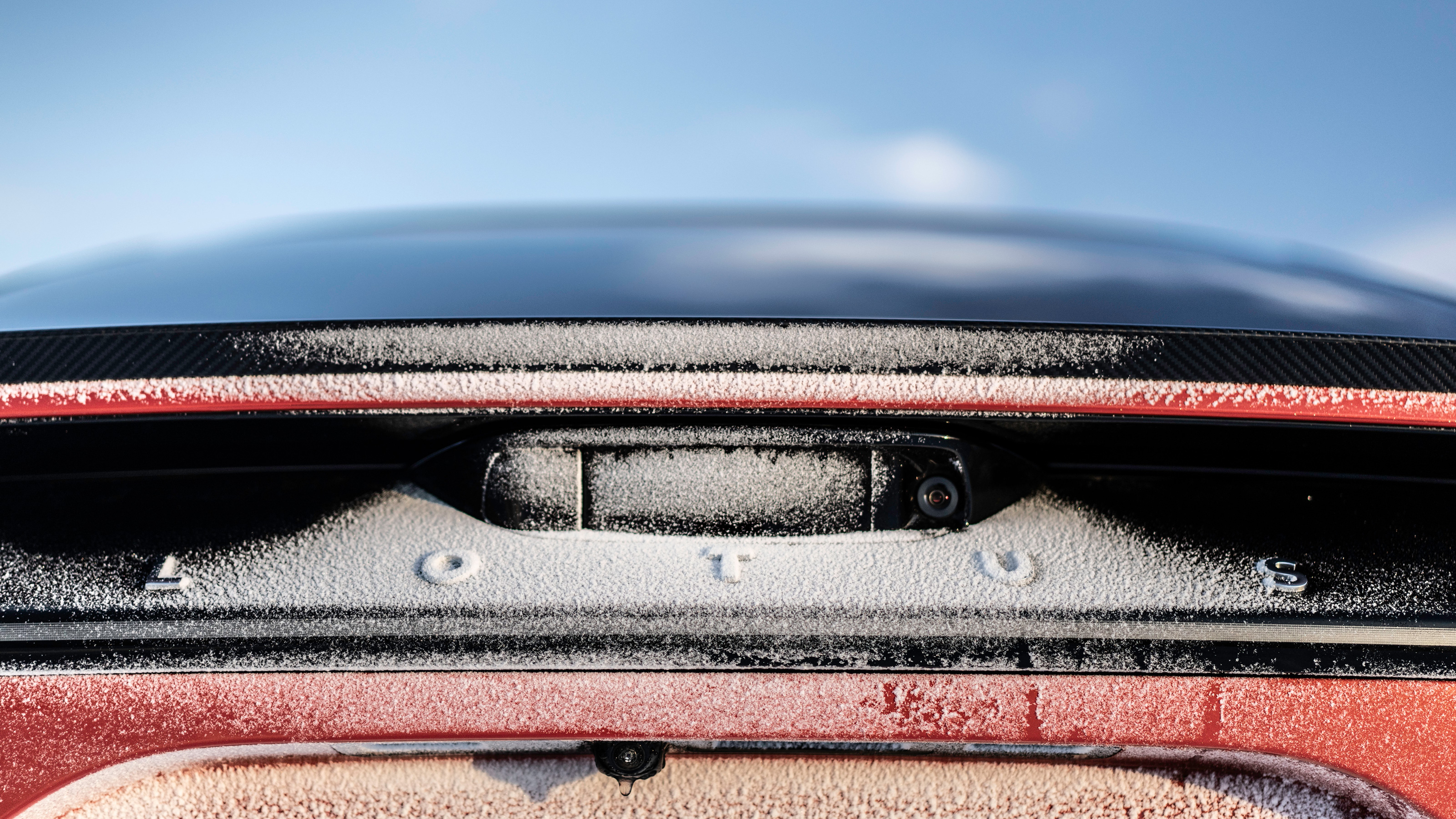
What the giddy aunt is a hyper-GT?
Good question. Developed under the codename Type 133, the Lotus Emeya is Hethel’s (well, Wuhan’s) answer to the Porsche Taycan, but it’s also been benchmarked against the Panamera. Lucid was another name that came up when I quizzed Lotus about rivals. Intriguing.
As is the hyper-GT schtick. The Emeya was initially billed as a saloon, but it’s too tall for that. Nor can you slap it with the same coupefied-SUV sticker that so many manufacturers are proudly wearing these days. Skoda Enyaq iV Coupe, Mercedes GLC Coupe, Porsche Cayenne Coupe… the list is as long as headroom is limited.
That said, it’s built on the same platform as the Eletre, shares many of its parts, and the two cars were engineered side by side. Hmm.
So… it’s an Eletre Coupe?
Not quite. The Emeya has a lower roofline, sure, but it also sits closer to the road. As does your backside. More focus on the driver, you see.
Lotus has achieved this by installing a thinner 102kWh battery under the floor. An odd choice at first glance for a car pitched as a continent-crossing grand tourer (sorry, a hyper grand tourer), but the company reckons improved internal properties and the Emeya’s smaller frontal area should spit out roughly as much range as the Eletre. Which manages 373 miles WLTP.
Roughly? Don’t they know?
Not yet. Or if they do, they’re not letting on. The car’s still being homologated so most of the performance figures are caveated with the letters T, B and C. But we can bank on most of them.
Powered by a dual-motor setup that delivers permanent AWD, the Emeya is good for 905bhp and 726lb ft. Yup, exactly the same as you get from the Eletre R. And yes, we’ll see mid-level S and entry-level versions of the Emeya with less power when it goes on sale later this year.
Anyway, the full amount of shove means 0-62mph takes 2.78 seconds. Yikes. And Lotus claims the Emeya will keep on pulling courtesy of a Taycan-imitating, two-speed transmission: 50-75mph is slated at less than two seconds. Top speed will be in the region of 159mph.
This all feels very un-Lotus…
I’m afraid you’ll have to get used to it. Following a grand master plan laid out by behemoth parent firm Geely, Lotus will be electric only by 2028. A new D-segment SUV will sit underneath the Eletre in two years’ time; 12 months later a new EV sports car will replace the Emira in the line-up. If the Evija sells out by then, there’s a very real chance Lotus won’t make a car weighing less than two tonnes. Let that sink in.
Don’t keep me in suspense any longer. What’s it like to drive?
I couldn’t possibly tell you.
Top Gear
Newsletter
Thank you for subscribing to our newsletter. Look out for your regular round-up of news, reviews and offers in your inbox.
Get all the latest news, reviews and exclusives, direct to your inbox.
Why not? It says ‘review’ in the headline…
TG’s first experience of the Emeya comes in pre-production form, with enough unfinished electronics and missing sensors for Lotus to play the work-in-progress card. Mind you, the launch of the final car isn’t far away so Lotus can’t have much homework left to do.
Also, this taster drive takes place exclusively on ice and snow at the UTAC winter vehicle testing facility, not far from Ivalo, Finland. Any deeper into the Arctic Circle and we’d be on 24-hour polar bear watch. At -2 degrees celsius, the locals called it ‘unseasonably warm’.
Fetch the sun cream! How did it cope?
Very well indeed. The suspension is mostly carried over from the Eletre - a car that rides and handles incredibly - and it felt just as well sorted here, soaking up bumps with ease and seeming immune to the lack of traction available on the white stuff. Winter tyres helped, for sure.
Nowhere was this more evident than on the frozen skidpan. You’ve got an active anti-roll system (which can shift the roll stiffness balance front to rear to induce under- or oversteer), torque vectoring via braking and active rear-wheel steering all working as one to stop your YouTube-worthy drift becoming News at Ten material.
Flicking through the driving modes gradually makes the power more rear-biased. Tour allows for a bit of slip but will keep you pointing the right way; Sport lets you get the tail out more but keeps the safety net at the ready. Track mode is where the electronics stop replacing driver skill: get a millimetre too greedy with the throttle and you’ll be one-eightying quicker than you can say ‘Exige’.
Again, only so much you can draw from a drive in these conditions. But the kindest thing I can say about it is that you get a real sense of the car pivoting around your hips, like you’re right in the middle of the inertia. It felt… like a driver’s ca-
Don’t say it! Did anything else surprise you?
The cabin. Forget the noise about its lightweight heritage, the single biggest revelation between Lotus of old and Lotus of now is the leap forward in interior quality. The Emeya’s is superb: it’s a genuine premium product. No doubt because the Geely parts warehouse has an aisle marked ‘Volvo’, but still. You can see why Lotus will likely charge close to six figures for the base model.
Instead of a big display, you look through the wheel onto a digital strip that shows you speed, driving mode, and not much else. The fewer distractions the better, argues Lotus. Correctly.
Almost everything else is housed on the 15.1in central touchscreen, which would normally be a cause for concern. Not here. The display is crisp, clear, and reacts promptly; the menus make sense, and are easy to navigate because the icons are big; the ADAS can be switched off in two finger jabs; the temperature control is a permanent fixture at the bottom of the screen. Easy peasy.
True, the steering wheel buttons and windscreen heaters are haptic jobbies (grr), but at least the drive selector’s a physical toggle. The tiniest morsel of manual action lives on. Yes, I am clutching at straws.
Is it a ‘proper’ Lotus though?
Listen, we are going to be asking this question of every new Lotus until the Elise drops out of living memory. Lotus’s view is that it wasn’t a profitable business when it was selling 500 cars a year, and even when it launched the S1 customers were coming back six months later and pointing out the roof was rubbish, the brakes should be servo’d and wouldn’t it be nice if it had electric windows… And what happened? It got heavier.
Granted, going EV is the extreme end of that trend but the modern world demands it. There isn’t a market for a small-batteried, 100-mile electric track car and so Lotus has to do what it must: make cars that people might actually buy in numbers. SUVs, hyper-GTs, whatever.
Driving done, I put this dilemma to Gavan Kershaw, who joined Lotus at 16 and is now, as 'director of attributes and product integrity', responsible for how all its cars drive. Is there anything to link Lotuses of the past with electric heavyweights like the Emeya?
“It’s been a summary in Lotus since the late 70s, early 80s: input is equal to output,” he explains. “And that is, if you turn the steering wheel 10 degrees, it's because you're expecting to go around that corner by using 10 degrees of input. It shouldn't be frantic, it shouldn't be delayed.
“Lotus is always confidence-inspiring, engaging… but it's something you work with. You're never trying to play catch up because it's doing something you didn't quite expect to happen. And that's been from the early Elites, Elans, Sevens, Elises, all the way through.
“And hopefully what you'll find today is that the car does exactly what you expect it to do, and it makes you want to drive it more. It makes you want to do that road again, or get up early and go a different route to work because you enjoy it. I don't think there’s a better product than something that makes you feel like that. You shouldn't have to go and hunt for its good bits.”
Featured

Trending this week
- Car Review
BMW iX3






